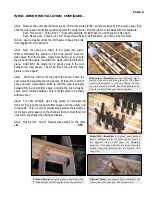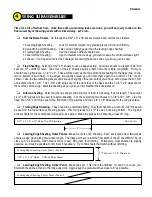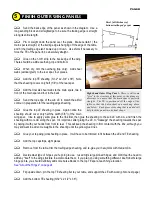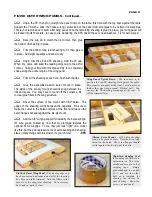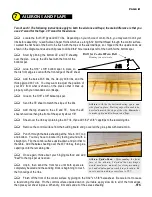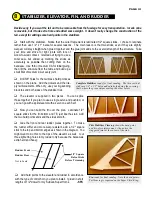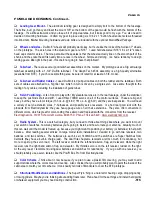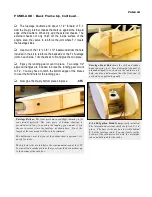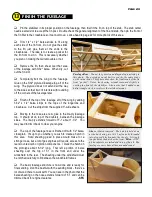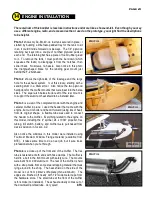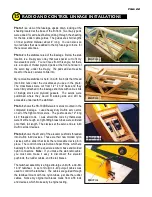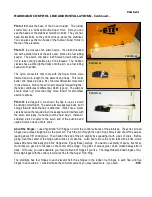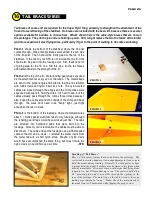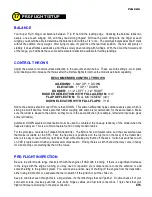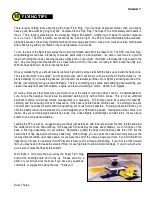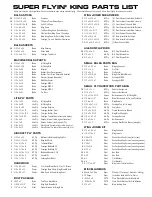
1 FUSELAGE DECISIONS >
No construction here, but this deserves its own section because I literally spent days thinking about these
items before starting on the fuselage. I'm the type that likes to plan way ahead when it comes to the engine
and radio installation. I can pass along info about the equipment in my prototype, but I don't have first-hand
experience with all the engines and accessories on the market. As an experienced builder, you probably
have your own ideas on how to approach these items. Use your best judgment...
Engine Installation -
I used a 3W-75i, a single-cylinder, rear-induction, electronic-ignition engine in the
prototype. For a long time I was stuck on the idea of mounting it inverted and trying to somehow hide the muffler in
the cowl or fuselage. Finally, I wondered, "Who am I trying to fool? This isn't a scale model; it's just a big model
airplane." With that, I went with an upright cylinder and a muffler hanging out in the breeze.
Muffler Position -
This goes hand-in-hand with your engine installation. The muffler on my engine is a large
canister type manufactured by 3W. The engine could have been mounted with the cylinder at a downward angle and
the canister hidden in the fuselage. However, that would have taken up cabin area that may come in handy later,
and even though the muffler would be hidden, the engine would have to stick out of the fuselage near the bottom on
one side - ugly.
Side Thrust -
I've never been a big fan of right thrust, but decided to try it on this model because of the high
power expected from the 3W-75i. I settled on two degrees of right thrust, and angled my firewall accordingly. Flight
testing has shown this to be TOO MUCH! My model definitely pulls to the right with the application of full throttle. For
that reason, I suggest using zero side thrust or perhaps a degree at the most. If you do add right thrust, simply
expand the front edge of the F-1 notches in the left-hand doubler. You should also offset the engine from the model's
centerline so that the prop shaft ends up centered at the front of the model.
Cowling and Spinner -
This is where builders will need to do their greatest amount of innovating, because of all
the possible engine/muffler choices and their positioning. Even though the model is very big, the firewall and cheek
cowl area is somewhat tight for a gas engine. You have to balance appearance with ease-of-access. Would a wider
firewall make things easier for you? Feel free to call and maybe I can cut a special one for your engine.
Fuel Tank Installation -
With the pumped carbs on most gas engines, fuel tank position is not critical. But you
need to be able to get it in and out, and it must be held securely when installed. Think about how you are going to
fuel and de-fuel. I used a fuel "tee" in the feed line (actually, it was an aquarium air line "tee" that I found at Wal-mart
for under a buck). The tee'd line is used for fueling; it ends at a fuel dot on the side of the model. Large tanks are
available from Sullivan and Du-Bro. My model uses a 40 oz. Du-Bro tank, although 32 oz. would have been plenty. I
also replaced the plastic cap with a machined aluminum cap from SWB Manufacturing. It's not necessary, but it's a
nice touch and gives a feeling of security. Fasten all of your fuel line connections with clamps or safety wire!
SWB Mfg., 1237 Hwy NN, West Bend, WI 53095. Phone: 262-0675-2848. www.swbmfg.com/
Ignition System -
If your engine has electronic ignition, you have to plan on the positions of your ignition
module, battery, kill switch, and charging jack. I bolted my module to the front of F-1, below the engine. The switch
and charge jack are on the left side of the model, opposite the muffler. It's very important to keep your radio receiver,
battery, and servos as far away from the ignition as possible to avoid glitches from the engine's ignition system.
Throttle Pushrod -
A wire or steel cable can carry ignition noise back to your throttle servo. You can avoid that
problem by using a plastic tube-in-tube pushrod for your throttle. Some gas engines with side-mounted carbs need
bellcranks to transfer the pushrod movement to the throttle arm on the carburetor.
9
PAGE 14
Содержание SUPER FLYIN' KING
Страница 2: ...TABLE OF CONTENTS 0 1 2 0 3 4 5 4 4 2 22 0 2 0 0 0 6 0 7 1 0 2 2 8 9 6 7 5 2 1...
Страница 22: ...0 1 2 3 4 1 5 6 7 PHOTO 1 PHOTO 2 PHOTO 3 PHOTO 4...
Страница 23: ...0 1 2 3 PHOTO 1 PHOTO 2 PHOTO 3 PHOTO 4...
Страница 24: ...4 5 4 6 4 0 7 0 8 0 0 9 4 1 PHOTO 5 PHOTO 6 PHOTO 7 PHOTO 8 PHOTO 9...
Страница 25: ...1 0 1 9 5 9 7 6 A PHOTO 10 PHOTO 11 PHOTO 12...
Страница 28: ...0 12 3 4 5 6 7 6 8 3 9 7 9...
Страница 31: ......






